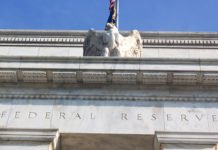Executive Summary
As the Fed considers what do with its $4.5 trillion dollar balance sheet and the implications these decisions might have on financial markets, we are reminded of Donald Rumsfeld’s observation that "it is easier to get into something than to get out of it."
When the Fed first raised rates in this cycle in December 2015, the FOMC announced its intention to continue rolling over its maturing assets until "normalization of the level of the fed funds rate is well under way." At the time, the Fed had just raised rates for the first time in almost a decade, meaning that "well under way" remained quite a ways off. Nearly a year and a half later, the Fed has increased the funds rate two more times and is signaling more hikes on the horizon.
The latest FOMC meeting minutes raised the level of urgency, with some members favoring balance sheet reductions by year-end 2017. Recent commentary by Fed speakers suggests momentum is building for a change. Cleveland Fed President Loretta Mester’s comments are a prime example: "Ending reinvestments is a first step toward reducing the size of the balance sheet and returning its composition to primarily Treasury securities over time."
In this report, we consider the factors that will drive Fed balance sheet policy, such as size, composition and timing. We then consider two scenarios under which the Fed may normalize its balance sheet: A baseline scenario, in which maturing assets gradually roll off, and an alternative scenario, in which we explore what it would take for the Fed to consider active sales of its assets.
How Did We Get Here in the First Place?
Prior to the 2008 financial crisis and the ensuing recession, the Fed’s asset holdings were about $900 billion, consisting primarily of Treasuries (Figure 1). During the crisis, the balance sheet temporarily held a diverse selection of financial instruments, such as commercial paper and currency swaps, to help mitigate the liquidity challenges that were unfolding in the financial system. Subsequent efforts to drive down long-term interest rates and thus stimulate the economy led to the various "quantitative easing" programs that brought the balance sheet to its current size of roughly $4.5 trillion, comprised mostly of Treasuries and mortgage-backed securities (MBS).
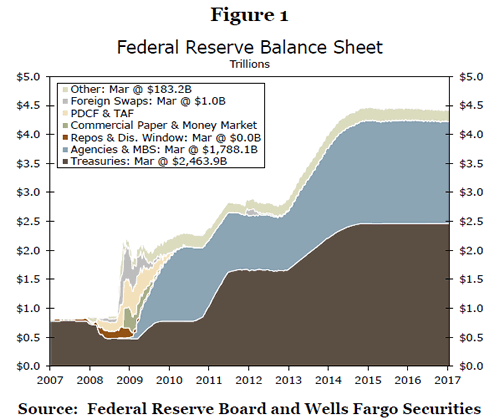
Fed holdings of MBS in such large quantities are without historical precedent. Past holdings of Treasuries, however, can help give us a sense of the role the Fed has played in the market for U.S. Treasuries in more ‘normal times’. Perhaps counterintuitively, the Fed’s share of the Treasury market plummeted at the onset of the last recession and remained below pre-recession levels for the first couple of years of the recovery (Figure 2). While this may seem odd at first, skyrocketing deficits during this period led to a surge in net treasury issuance (Figure 3). In addition, the Fed’s initial purchases were more focused on assets other than Treasuries, such as MBS. Thus, at least initially, the size of the Treasury pie (or the amount of outstanding debt) grew, while the Federal Reserve’s slice did not. When the Fed implemented the first and second rounds of quantitative easing (QE), these programs boosted the Fed’s holdings of U.S. debt up from a historically low share. The last round of QE helped flip the narrative. QE3 brought the Fed’s holdings of U.S. Treasuries, when viewed as a share of total outstanding, up to new highs. This occurred as an improving fiscal outlook simultaneously brought down the pace of new Treasury issuance.
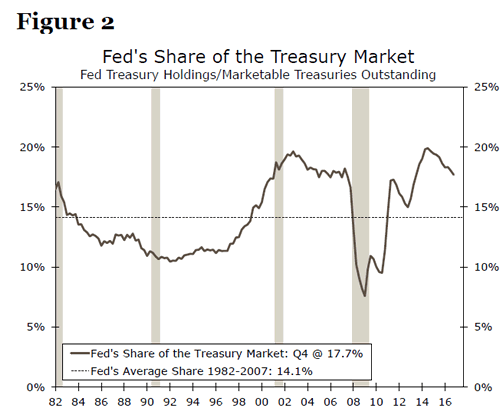
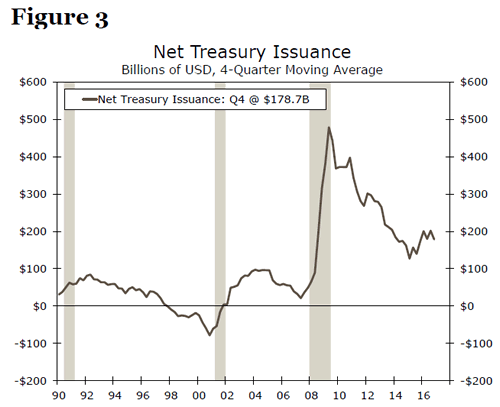
If the Fed unwound its balance sheet and returned its holdings to its average share of the Treasury market from 1982-2007, it would still hold slightly less than $2 trillion in assets, which in nominal dollars would be historically quite high relative to its pre-recession holdings. Returning to the average from the more recent 2000s would yield an even larger balance sheet. Writing for Brookings earlier this year, former Fed Chairman Ben Bernanke discussed balance sheet reductions and maintained that "it’s not unreasonable to argue that the optimal size of the Fed’s balance sheet is currently greater than $2.5 trillion and may reach $4 trillion or more over the next decade."2 These estimates highlight that the Fed is unlikely to reduce its holdings to anywhere near pre-recession levels. Although the Fed’s total balance sheet remains quite large, the economy has ‘grown into’ the Fed’s balance sheet over the past decade, a phenomenon that should continue in the years ahead. Even still, if the rough estimate for the appropriate size of the balance sheet is somewhere in the neighborhood of $2 trillion-$2.5 trillion, there is clearly still scope for the Fed to begin reductions at some point in the near future.
The Path Forward: What Might the Road to "Normal" Look Like?
Fed guidance on the timing and structure of balance sheet reduction has been fairly tight-lipped until recently. However, based off of the Fed’s "Policy Normalization Principles and Plans,"3 the following points appear likely to serve as key guidelines:
- "The Committee intends to reduce the Federal Reserve’s securities holdings in a gradual and predictable manner primarily by ceasing to reinvest repayments of principal on securities held in the System Open Market Account (SOMA)."
- "The Committee currently does not anticipate selling agency mortgage-backed securities as part of the normalization process, although limited sales might be warranted in the longer run to reduce or eliminate residual holdings. The timing and pace of any sales would be communicated to the public in advance."
- "The Committee intends that the Federal Reserve will, in the longer run, hold no more securities than necessary to implement monetary policy efficiently and effectively, and that it will hold primarily Treasury securities, thereby minimizing the effect of Federal Reserve holdings on the allocation of credit across sectors of the economy."
In short, the Fed appears set to 1) allow maturing assets to roll off rather than outright sell securities and 2) gradually return its holdings to primarily Treasury securities over the long-run. Given this, we outline two illustrative scenarios to highlight the different paths ahead.
Scenario 1: The Passive Approach
Under this scenario, which we consider our baseline, the Fed will cease reinvesting the proceeds of its maturing securities, passively winding down the balance sheet in the process. As illustrated in Figure 4, more Treasury securities come due in 2018 than any other year. With a slightly longer time horizon, the Treasuries held on the Fed’s balance sheet are front-loaded; nearly one-half of the Fed’s $2.4 trillion in Treasury holdings come due between now and 2020. The maturity schedule leaves the Fed well-positioned to adopt this passive approach while still making a material impact on the size of its balance sheet. This route is also consistent with the Fed’s stated goal of avoiding outright asset sales for the time being and is thus the least likely policy to roil financial markets. In an effort to smooth the process and avoid another "taper tantrum" episode, the initial reductions may entail reinvesting a significant fraction of the maturing assets. For example, for every $100 that comes due, the Fed could choose to reinvest $75 of that original $100, slowing the pace of balance sheet reduction more than the maturity schedule would suggest. Then, as economic conditions warrant and financial markets adjust to this new change in monetary policy, the Fed could begin to reduce the fraction of maturing proceeds it reinvests.
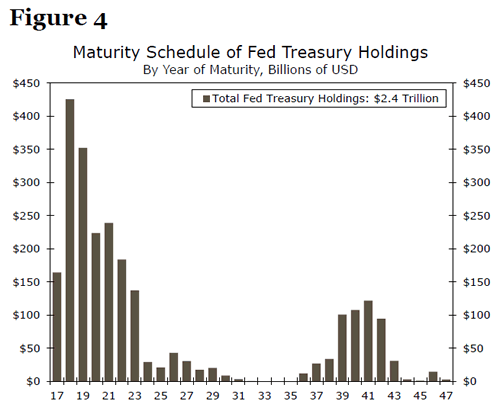
For Treasuries, this approach is fairly straightforward. On the MBS side of the portfolio, however, the balancing act is a bit more complicated for the Fed. As highlighted above, over the long-run the Fed would prefer to hold only Treasury securities to minimize its influence on the private allocation of credit. However, unlike the fixed maturity schedule of Treasuries, the passive approach to reducing MBS holdings leaves the Fed at the whim of forces outside its control. Prepayment on MBS, due to refinancing, mobility, downsizing/upsizing, etc., all influence the pace at which these securities will mature. Figure 5 illustrates a hypothetical scenario of how Fed holdings of MBS could evolve if they were allowed to pay down without being reinvested.4 At current rate levels, about $180 billion could pay down in 2018, a sizeable amount relative to the approximately $225 billion in net MBS issuance expected per year. This reinforces the notion that the Fed will likely choose to reinvest a share of the MBS proceeds to reassure financial markets that the balance sheet reductions will not be too sharp and the impact on markets rates will be more limited.
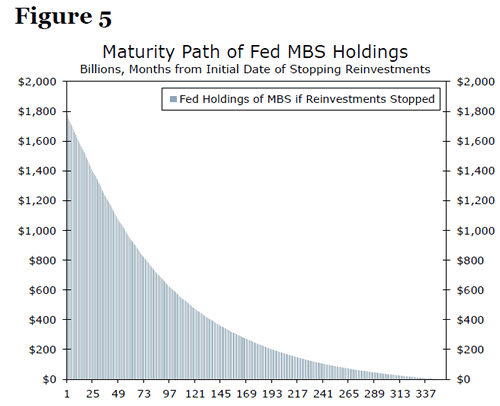
In our view, the Fed most likely will propose starting the process by allowing maturing securities to roll off by year’s end, through a combination of MBS and Treasury reductions. In order to prevent a taper tantrum repeat, the Fed will likely try to signal this well in advance and choose to reinvest a sizable percentage of the maturing assets, smoothing the transition. The comments from Cleveland Fed President Mester and the latest Fed minutes offer examples of this messaging. If all proceeds according to plan and the economy continues to improve, the Fed would then gradually reduce the share of its reinvestments to normalize further.
Scenario 2: What Would It Take for the Fed to Commit to Outright Sales?
Given the above scenario, under what circumstances might the Fed consider outright sales of its assets? We doubt that the Fed will sell a meaningful quantity of MBS or Treasuries any time soon. Our interest rate strategists think that sizable sales could unnerve these markets. Indeed, although the Fed has explicitly stated it intends to wind down the balance sheet through ceasing reinvestments, it has also admitted that there is a chance that "limited sales [of MBS] might be warranted in the longer run to reduce or eliminate residual holdings."
A sharp change in the economic outlook could warrant asset sales of Treasuries, MBS or a combination of the two. If, for example, a sizable economic stimulus package ramped up economic growth and stoked faster inflation, the Fed might consider a more active approach to normalizing monetary policy beyond the fed funds rate. Alternatively, a shift in the composition of the FOMC could also lead to a more active approach than is currently anticipated. There are currently two open spots on the FOMC, and soon to be a third with the departure of Governor Tarullo. With Chair Yellen’s term set to end in February 2018 and Vice-Chair Fischer’s term ending that summer, President Trump and the Republican Congress have the opportunity to dramatically reshape the FOMC in the years ahead.
If the new Board members adopted a more hawkish/traditional approach that sought to return the Fed’s balance sheet to a much smaller portfolio comprised primarily of Treasuries, this could lead to a more rapid reduction in MBS holdings. As illustrated in Figure 5, even if all maturing MBS over the next five years were allowed to roll off, at current rate levels MBS holdings could still be nearly $1 trillion, a far cry from pre-recession normalcy. The incoming policymakers could view this as unacceptably slow and ramp up the process in order to more rapidly exit the MBS market. Again, although this is not our baseline scenario and would likely play out over several years, it bears close watching given the Fed’s competing goals of returning to primarily Treasuries holdings over the long-run and a desire to gradually and passively reduce the balance sheet without disrupting financial markets, the housing market or the overall economy.
Other Balance Sheet Considerations: The Greenspan Conundrum Could the Balance Sheet Offer the Fed Greater Flexibility?
In testimony before Congress in 2005, then Federal Reserve Chairman Alan Greenspan described the difficulty the Fed was encountering as longer term interest rates were not especially responsive to increases in the fed funds rate, a situation Chairman Greenspan famously referred to as a "conundrum."5 Later in that same year, then Governor Ben Bernanke expanded on the potential causes of the Greenspan conundrum, citing an oversupply of investment dollars from foreign investors, which drove longer dated bond prices up and pushed yields lower.6 Arguably a similar situation exists today and this foreign demand for longer-dated Treasuries becomes even more pronounced when volatility contributes to a flight-to-safety move by investors.
The flattening of the yield curve first observed by Greenspan in 2005 eventually gave way to an inverted yield curve at various points of time between 2005 and 2007 (Figure 6). Since 2014, the yield curve has been flattening again, with the spread between the yields on the 10-year and two-year Treasury returning to the level that prevailed at the time of the Greenspan conundrum.

Our interest rate forecast has short term rates rising faster than longer term rates and thus implies a continuation of this flattening trend. In this scenario, the swollen balance sheet of today’s Fed offers some additional monetary policy flexibility vis-à-vis the Fed of the Greenspan era. Rather than waiting for the Treasuries it holds to come to maturity, the Fed might instead sell longer-dated Treasury securities on the open market. All else equal, the additional supply should push prices down and drive yields higher at the long end of the curve.
Relationship between Fiscal & Monetary Policy Isn’t a One-Way Street
There are a number of Republican members of Congress who would like to see the Fed get out of the housing market and unwind some or all of its $1.8 trillion portfolio of MBS and agencies. In many instances, these are members of Congress who also place a high value on balancing the federal budget.
As Figure 7 shows, Congressional Budget Office estimates suggest that the fiscal budget deficit is poised to worsen over the next few years. Without making a value judgement about whether or not the Fed "should" maintain a large balance sheet, the Fed’s large holdings currently help reduce the budget deficit. In an environment of rising deficits and policy proposals for which finding the funding is often a major challenge, reduced remittances to the Treasury cannot be ignored. As illustrated in Figure 8, Fed earnings remitted to the Treasury over the past 12 months add up to roughly $90 billion. Without those remittances, last year’s fiscal budget deficit would have been 16 percent larger.
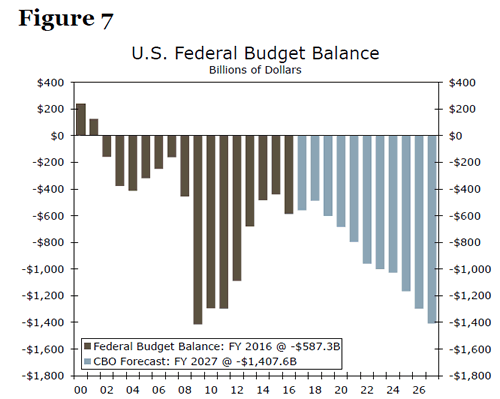
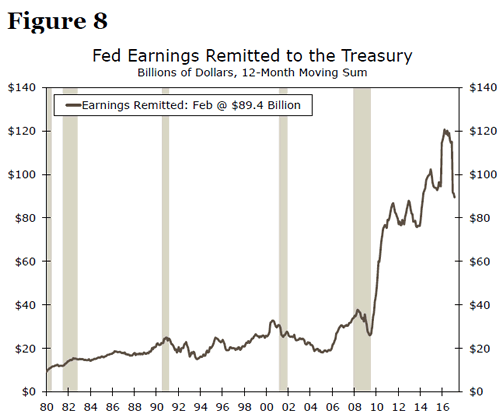
Furthermore, despite a debt-to-GDP ratio that has doubled since the Great Recession began, net interest costs as a share of GDP have remained historically low (Figure 9). With monetary policy tightening likely driving interest rates higher, this represents yet another way in which monetary policy can influence the fiscal side of the economic policy equation.
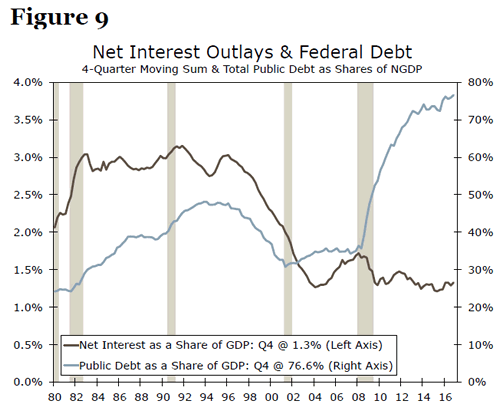
When the Levee Breaks
We do not expect the Fed to fully liquidate its balance sheet or fully ‘normalize’ its portfolio holdings. The next recession is coming. The next recession is always coming, and our baseline expectation is that this cycle has at least a couple more years to go. However, we would be remiss not to point out that in three months, the length of the current expansion will be eight years. The longest expansion on record is 10 years.
The Fed has lowered its estimates of what it considers the appropriate level for the fed funds rate in the longer-run from 4.25 percent in 2012 to 3.0 percent today.8 The ultimate terminal fed funds rate will likely be lower when the current cycle comes to an end that it has been in prior economic cycles. With limited scope for the Fed to cut rates when the next recession comes along, whenever that may be, the Fed may have to go back to the well of quantitative easing. This could entail resuming reinvestments or even returning to asset purchases, depending on what economic conditions warrant.
Normalization of the Fed’s balance sheet is an important consideration and will become a focus of both monetary policymakers and financial markets in the months ahead. Monetary policymakers will be challenged to find a balanced path that begins the process of unwinding years of unconventional monetary policy while simultaneously keeping the economic expansion chugging along. The various scenarios considered in this paper are offered to help decision makers frame their thinking and make informed decisions as this process unfolds.






